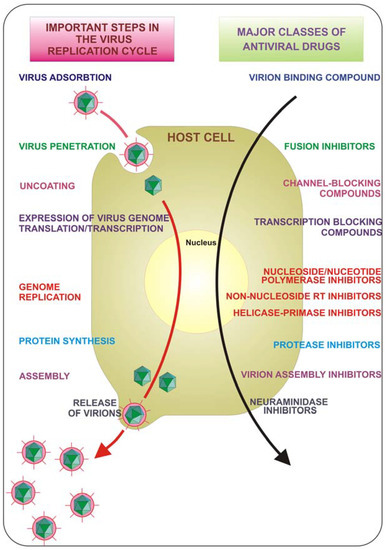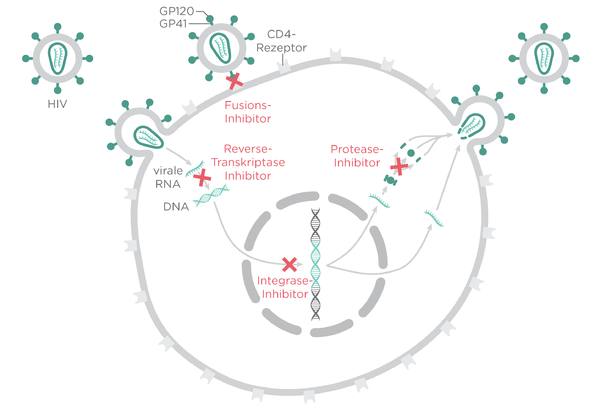Describe the Modes of Action Used by Antiviral Drugs
1 drugs interfering with metabolic processes. Entry Inhibitors interfere with the receptor-mediated entry of the virus into a cell.
While the cellsof humans and animals do not have cell walls this structure iscritical for the life and survival of bacterial species.

. Antiviral drugs are a class of medication used for treating viral infections. Two subclasses known as fusion inhibitors and CCR5 antagonists are new classes of antiretroviral drugs used in combination therapy for the treatment of HIV infection. Antiviral medication and its mechanism of action Acyclovir.
Most of the anti-HIV drugs target one of the viral enzymes either the reverse transcriptase the protease or the integrase Table 2. Antiviral drugs available by prescription can reduce the time it takes for symptoms to improve and some are also used in selected situations to reduce the chance of. Please visit our nursing test bank page for more NCLEX practice questions.
There are prescription medications called antiviral drugs that can be used to treat flu illness. Aciclovir can be administered through oral route or can be applied as a cream or by injected. Targets of Antiviral Drugs Antiviral drugs generally target the following.
Acyclovir is the basis of 2-deoxiguanosin which applies antiviral effects after manipulation on acyclovir. Virus-specific enzymes eg reverse transcriptase integrase inserts viral DNA into host DNA proteases process viral proteins Viral DNA replication transcription drugs inhibiting these processes may kill host cell also Fusion of enveloped viruses. Blocking the integration of viral genetic material into the host genome.
Hepatitis C virus infections. The antiviral drug combination known as highly active anti-retroviral therapy HAART is targeted at blocking the use of the HIV RNA to manufacture DNA which is then used to make the viral components. And blocking adhesion of the virus to host cells.
- Enfuvirtide binds to an HIV protein that mediates fusion of an viral envelope with the cell membrane thus preventing entry into cell. 1 attachment and penetration of the virus into the host cell 2 uncoating of virus eg removal of the protein surface and release of the viral DNA or RNA 3 synthesis of new viral components by the host cell as directed by the virus DNA 4 assembly of the. The action of some drugsincluding inhalation anesthetic agents osmotic diuretics purgatives antiseptics antacids chelating agents and urinary acidifying and alkalinizing agentsis attributed to their chemical action or physicochemical properties.
A 15 yo patient came in for a severe case of respiratory flu and would need drug therapy. Inhibitors of cell wall synthesis. Most antivirals target specific viruses while a broad-spectrum antiviral is effective against a wide range of viruses.
This class of drugs interferes with the binding fusion and entry process of HIV into a. An antiviral agent must act at one of five basic steps in the viral replication cycle in order to inhibit the virus. Lower the viral load amount of active virus in the body.
-Maraviroc blocks the HIV coreceptor CCR5. Mechanisms of Action of Antiviral Drugs by Jackie Allen. Mode of Action of acyclovir.
Unlike most antibiotics antiviral drugs do not destroy their. In particular there are many drugs that block reverse transcription an enzymatic activity not expressed in normal cells. Acyclovir drugs used for the treatment of herpes simplex virus infections chickenpox and shingles.
Block receptors so viruses cant bind to and enter healthy cells. A new group of drugs in the anti-HIV arsenal. And 3 drugs interfering with neuromuscular physiology of parasites.
Monitor patient compliance to drug therapy. CDC recommends prompt treatment for people who have flu or suspected flu and who are at higher risk of serious flu complications such as people with asthma diabetes including gestational diabetes or heart disease. The mechanisms of action of antiprotozoal and anthelmintic drugs are reviewed according to.
Common Antibacterial Drugs by Mode of Action. An analysis of the action mechanism of known antiviral drugs concluded that they can increase the cells resistance to a virus interferons suppress the virus adsorption in the cell or its diffusion into the cell and its deproteinisation process in the cell amantadine along with antimetabolites that causes the inhibition of nucleic acids synthesis. Penicillins cephalosporins monobactams carbapenems.
One of the primary differences between antibacterial and antiviral drugs is how they act toward the target pathogen. 2 drugs interfering with reproduction and larval physiology. Mode of Action Entry Inhibitors.
For example a great many antibacterial drugs are bactericidal namely that they actively seek out destroy and kill the target pathogen. Valacyclovir L-valyl ester from acyclovir is also available in oral. Antiviral Drugs Mode of Action Nucleic Acid Synthesis Non-Nucleoside Polymerase Inhibitors Inhibit viral polymerases by binding to site other than nucleotide-binding site Foscarnet used to treat ganciclovir-resistant CMV and acyclovir-resistant HSV Non-Nucleoside Reverse Transcriptase Inhibitors.
Prevents the virus from entering host cell. Boost the immune system helping it fight off a viral infection. The principal mode of action of 3TC-TP is inhibition of the RNA- and DNA dependent polymerase activities of HBV reverse transcriptase rt via DNA chain termination after incorporation of the nucleotide analogue.
Common side effect of this drug is nausea and diarrhea and serious side effects are kidney problems and low platelets. Intracellularly Lamivudine is phosphorylated to its active 5-triphosphate metabolite Lamivudine triphosphate 3TC-TP. Antiviral medicines work differently depending on the drug and virus type.
Most antiviral drugs have just one single target whereas other antiviral drugs have a broad-spectrum of activity. Inhibition of membrane fusion. Inhibit cell wall biosynthesis.
Inhibit biosynthesis of proteins. Different antibiotics have different modes of action owing to thenature of their structure and degree of affinity to certain targetsites within bacterial cells. Here are some practice questions for this study guide.

Molecules Free Full Text Silver Nanoparticles As Potential Antiviral Agents Html

Major Sites Of Antiviral Drug Action Download Scientific Diagram

No comments for "Describe the Modes of Action Used by Antiviral Drugs"
Post a Comment